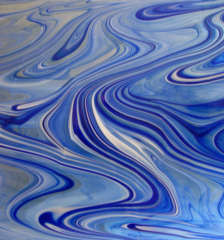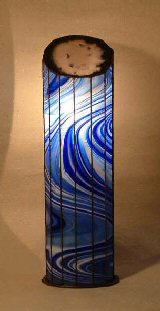The speciality of my work
One wonders what makes these Tiffany-objects so special and new and of course so expensive except for the
agate and the glass. The answer is: Tiffany forms the surfaces from models. Me on the other hand I construct
without any leaning form and I therefore have to grind the glass pieces exactly. The first method does have the
opportunity to produce on mass. My way of work appears to be lengthier, but therefore every artwork of mine is
unique.
 The fact that the glass plates which I use are neither of the same thickness nor of the same
shape (as it is with window glass) does make the manufacturing a lot more difficult. Although the mismatches
are only in the lowest mm range.
The fact that the glass plates which I use are neither of the same thickness nor of the same
shape (as it is with window glass) does make the manufacturing a lot more difficult. Although the mismatches
are only in the lowest mm range.
Without the grinding in mitres the width of the joints would double in size. The amendment of these mismatches
means that one has to invest a lot of patience, accurate coordination and perfect eye sight into the production.
On top of that a lot of the glasses are not homogeneous. Some of the glasses contain air bubbles and also the
structured surface makes it difficult to cut the material in small stripes. Different hardness and width
variation melted together appear to bring " bad surprises " when breaking the stripes.
Also the high risk of breaking the artwork the further procedure is very time-consuming. Glass stripes of a width
of 20mm and a length of 600mm do break easier than small glass pieces of square shapes. So they have to be
handled with special care. Finally the soldering does bear the risk of cracking the glass which makes the
production the even more expensive.
Now you probably ask if there is not an easier way of producing these items as there is in the technique of
Tiffany? The answer is NO. Tiffany could not manufacture continuous patterns because of the bend-crack. There is
always a joint with a distance which appears to be missed in the pattern. Because of the continuous grain one
gets an impression of a compact unique specimen. Otherwise they would be very defective. I also leave the agate
to form its later corpus itself. It is not pressed into a standardized form. My variation of forms is delivered
by the nature and my ability to form the agate.

The pattern of a unique glass pieces contains an agate slice. Out of two individual pieces of material I create
one unique piece of art. Most times the two elements seem to be meant for each other. What I am trying to say is
that it is worth the effort. The brief elegant forms and the handling of the colour effects create a timeless
aesthetics. These objects are going to be modern for a very long time and are more than just a lamp.
The very difficult way of producing these lamps makes it almost impossible to create similar objects. In addition
that most of the tools I work with are developed by me. Only licensed manufacturer would get proper instructions
for the method of building up the perfect body, the diamond grind and absorbability.
